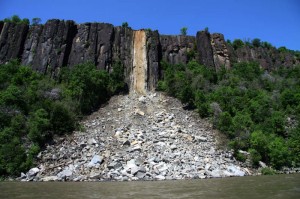Lamont-Doherty Earth Observatory158
-

Final Days in Alert
Time is flying, bringing us to our final days in Alert. We were able to recover samples from 12 stations, which is a great success and the second most successful year on record. Thanks to everyone who made it happen: Dale, Richard and Dan who went out every possible day to collect samples; Al and…
-

A Walk against Cancer
Alert hosted the first northernmost cancer-fighting fundraising event “Relay for Life,” an event sponsored by the Canadian Cancer Society to celebrate cancer survivors, remember loved ones lost to cancer and fight back against all cancers. The 12-hour-walk was organized by Kristy Doyle, who lost her grandfather to cancer in 2010. Participants raised a whopping $7,580 and collectively…
-

Rock Fall Shakes New Jersey Palisades
A 500-foot rock face came crashing down from the Palisades cliffs along the Hudson River in Alpine, N.J. on Saturday night, shaking the ground for more than half a minute and dumping a fresh layer of boulders over a 100-yard strip of parkland below State Line Lookout. The shaking was strong enough to be registered…
-

A Rare Treat – The Green Flash
Sunday night after successfully recovering a gravity core about 42 miles north of the equator, conditions were right for a rare treat – the green flash.
-

What’s a tree like you doing in a place like this? Or West meets East
In the northeastern part of Turkey, the highest Pontic Mountains meet the Black Sea. Here altitude drops from more than 3900m to sea level in a less than 30 miles. Both the orographic effect of mountains and the lake effect (well, better sea effect) cause very high precipitation allowing for rich and productive temperate forest…
-

A Visit to Crystal Mountain
The weather has improved considerably and we were able to fly out today to collect more samples. Yesterday, some of us went to explore Crystal Mountain, a 900-foot peak about five miles from Alert that offers an excellent view of the surrounding landscape. Alert is a Canadian military station located in the far north region…
-

Tree-Ring Science in a Log Yard?
The cool, snowy weather really put a crimp in our plans. Dario, Tuncay, Cengis, and others spent two days trying to find potential sampling locations before Nesibe and I arrived. Even though it had been well above freezing during the day and above freezing at night, the snow had only retreated so far in the…
-

Ice cores…finally
Today I got another chance to go out with team CASIMBO to drill ice-cores. The weather was beautiful with no wind, a few clouds, bright sunshine and a balmy temperature of about 5 degrees F. When I first saw sea ice near Alert a few years ago, I was very surprised. It wasn’t anything like…

AGU25, the premier Earth and space science conference, takes place December 15-19, 2025 in New Orleans, Louisiana. This year’s theme—Where Science Connects Us—puts in focus how science depends on connection, from the lab to the field to the ballot box. Once again, Lamont-Doherty Earth Observatory and Columbia Climate School scientists, experts, students, and educators are playing an active role, sharing our research and helping shape the future of our planet. #AGU25 Learn More

